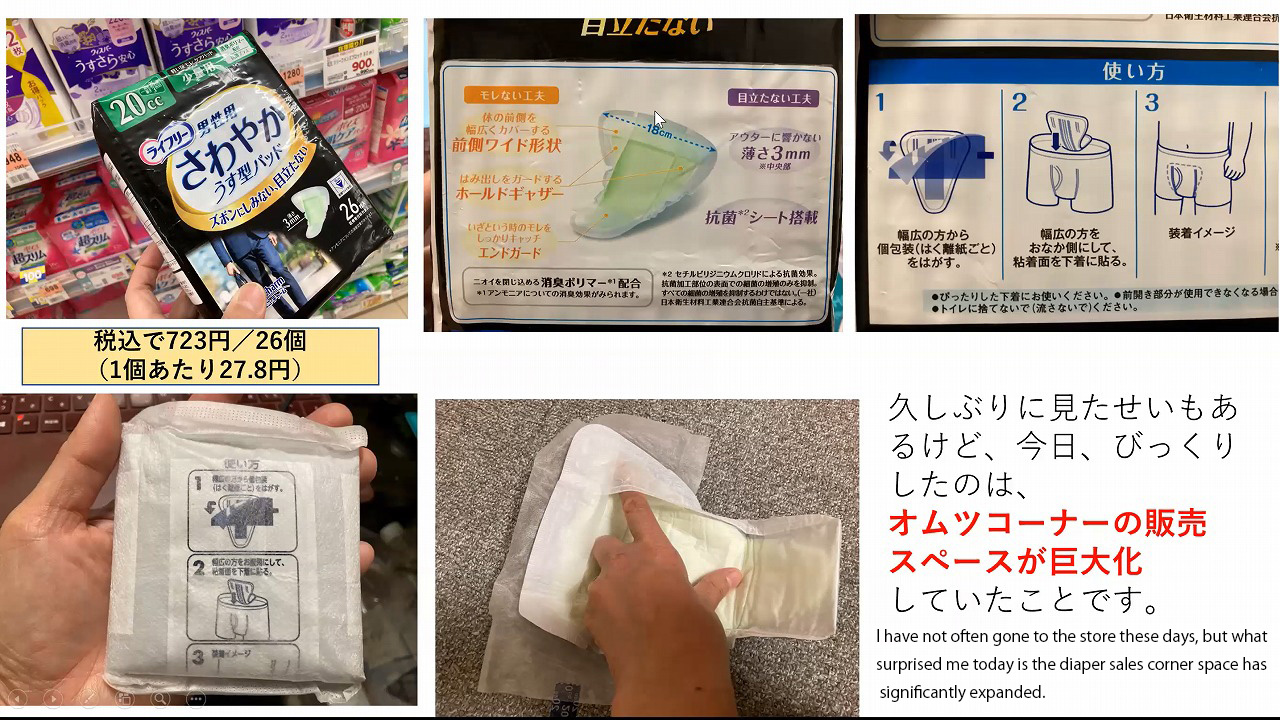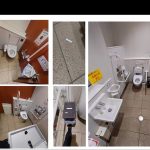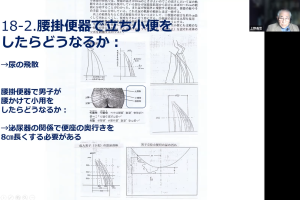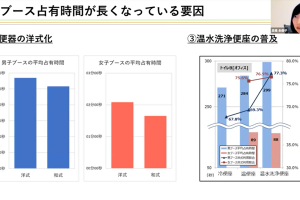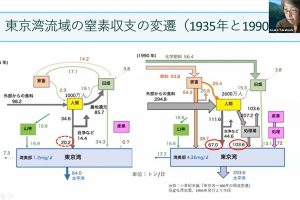Japan Toilet Association (JTA) Seminar Series,
Title: The 10th seminar
“Even men require a litter box in the toilet !”
– Request for a litter box as gender-free !-
Date: 24 February 2022 (Thu) 18:00-20:00 JST
Presenters:
Kohei Yamamoto, Vice Chairperson of Japan Toilet Association,
Chairman of Dynax Urban Environment Research Institute Co., Ltd.
Toyohiko Sunaoka (Taro Tora), Secretary General of Japan Toilet Association,
Former Rental Nikken Director and Managing Executive Officer of Nikken Corporation.
Organizer:
Yoshihiko Kawauchi, Ph.D., Japan Toilet Association vice chairperson,
Former professor of Toyo University.
(1) Issues
Kohei Yamamoto:
I want additionally a litter container in the men’s toilet. I think now it will be also necessary to consider about the name of the container. More people are experiencing some incontinence in the aging population.
Taro Tora:
I have the congenital osteoarthritis. I couldn’t live without taking painkiller medicines since I was 30 years old. I couldn’t live a normal daily life and couldn’t sleep at night from my 40s unless I took a fairly large suppository three times a day in addition to the medicine. I couldn’t sleep well at night by the pain. Some stains spread on the buttocks of the suit due to the leak of the suppositories. I had to put the women’s menstrual napkins every day for five years up to 55 years old, as there was no incontinence pad for men at that time.
I had to replace the menstrual napkins several times a day when I sweat. I changed it three or four times a day in the summer days. However, there was no litter box in the men’s toilet. Sometimes I couldn’t exchange all day long while the business trip. However, I hesitated to ask anybody that a litter box was necessary in a men’s toilet. Mr. Yamamoto also claimed that he needed an incontinence pad when he got sick. I have found out eventually there is a person close to my situation.
Kohei Yamamoto:
60% of men of 60s suffer from the benign prostatic hyperplasia. 80% of their 70s and 90% of their 80s are affected. The main symptom of the benign prostatic hyperplasia is the dysuria when getting older, and it becomes difficult for everyone to urinate. There are other symptoms such as feeling of the residual urine or increasing the number of toilet use. It is distressed that small stains were formed in front of the trousers.
My illness is the spinal canal stenosis, which often causes the dysuria due to the nerve compression. The bladder cancer is predominantly for males rather than females and the disease also causes the dysuria. Consequently, the dysuria is a serious male problem and that is why we surveyed with a questionnaire.
The followings are reports of our survey.
——————————————————————————–
(2) The survey results
(2-1) The analysis of selective answers
Takahashi:
I am Mikiko Takahashi of COMANY. The first survey was conducted by the Internet between on 1 February and on 22 in 2022 in order to collect the actual situation. There were 557 participants including overseas. The males were 336 (60.1%), females were 200 (35.6%) and 21 were reserved. There was less numbers of young participants and majority respondents were in their 40s or older. 16% of women and 12% of men use some kind of aids such as the incontinence pads, diapers, clean cotton and catheters for the excretion.
There are few young people who use some kind of aids and it tends to increase as getting older. 24.1% of people in their 70s or older use them. It turned out that 52.5% of males and 75% of females use commonly the incontinence pad.
This is a large difference that 42.5% of males used diapers and instead only 3.1% of females used them. It is presumed that females use the incontinence pad instead of the diaper, as they are accustomed to using menstruation products. Maybe many males don’t know about the existence of incontinence pads, or they are wondering where they are selling, and many of them use diapers eventually.
As we surveyed this questionnaire in the form of multiple answers, some people answered that they used not only one but a combinational of multiple things. Some of them complained about his troubled experience without a litter box in the men’s toilet. The answers are from males since most of boxes are installed in women’s toilets. About 70% of the males using the aid had experienced troubles of no place to throw it away.
When asked what to do if there was no litter box, 62.5% of the respondents answered; 1st. They had to bring back to the home, 2nd. They put it in another litter box in the toilet lobby, 3rd. They left it in the large litter box in the facility. 4th. Some replied that they left them in the toilet cubicle.
——————————————————————————–
(2-2) The analysis of questionnaire responses
Koji Yamamoto:
I am Koji Yamamoto of Central Nippon Expressway Co., Ltd. Japan. I analyzed the questionnaire responses in the free format with the text mining method and the Correspondence Analysis to find out the relations between the attributes of the people and their requirements.
More than 500 participants answered the questionnaire. Narrowing down among them to the parties and categories who use the aid, 23 people of 14 males and 9 females answered the questionnaire. These answers were from many old people rather than young ones. Many people use the incontinence pads and some of them also use diapers in parallel. The ostomate pouches are also cast in the litter box.
A high ratio of participants answered in multiple terms on the disposal ways. There are various ways that the most people bring it back to the home or dump to the litter box in the cubicle, the litter box in a multi-functional toilet or in the toilet common space, outside the toilet in a commercial facility. A few could not think of a good way and left it behind the toilet bowl or flushed down to the drain.
(Correspondence Analysis)
A high ratio of 22 people requested the necessity of a litter box in the accessible toilet. Since multiple answers are allowed, the total number of answers is more than the total respondents.
On the contrary, there were some opinions that litter box will not be necessary in the men’s toilet. Some claimed the smaller number of the accessible or ostomates toilets and some demanded more cubicle space to change the diapers.
Many men increasingly use toilet bowls for the urine recently and the usage time of the cubicle is longer due to unexpected use. There are many requests to increase the number of cubicles.
The Correspondence Analysis processed the relations between user attributes and aids as the external variables. It was particularly found from the results of the Correspondence Analysis that the aid users and caregivers requested the installation of litter boxes in men’s toilet cubicles. There were also requests to increase the number of the wheelchair accessible toilets with the litter boxes.
There were the other comments that the incontinence pad could throw away in the litter box but the container volume must be larger for the stool leak pad or diaper. The common toilet cubicles were less spacy to replace aids or install a litter box for diapers. Some women using the aids pointed out the existent litter box was too small to throw away.
The aids users mainly use the accessible toilets or ostomate-compatible toilets. It is conceivable to start by placing a litter box in a spacy accessible toilet or an ostomate-compatible toilet. Moreover, it is necessary to appeal to increase the number of the accessible toilets.
However, these ways do not mean that the litter boxes are not always necessary in the common toilets.
(Future Issues to be considered)
More people will use these aids as the elderly population continues to increase. The aids to be thrown away as the litter vary from place to place. For example, on the express way, many people are using diapers because the incontinence pad is not enough for the long trip. Whereas when visiting to a department store or a fashionable place, they may use an inconspicuous incontinence pad. However, these phenomena are not well been confirmed yet.
An incontinence pad can bring back to the home, but it is hard to do with a bulky diaper. It must be necessary to find out which ones are often used in which facility and decide the litter box size there.
Furthermore, it must consider whether it is necessary to install all the men’s and women’s toilets, or only to install in some of them. The litter box is too small to hold the diapers and sometimes the incontinence pad may be fully filled with according to Saitama City where is the advanced initiatives in the toilet facility. It is necessary to determine the size of the litter box depending on what kind of aids will be thrown away.
However, when there is a bigger one, the not applicable lunch boxes or the plastic bottles may be thrown away, or suspicious people may put in the camera for the purpose of voyeurism. We must think of ways to deal with such unexpected use. Furthermore, it is necessary to consider the increased load of the on-site cleaners for the litter boxes. We also have to develop of an easy to clean litter box.
Saitama City recently announced that it will install litter boxes and bins in public men’s toilets. Currently there are three locations to be installed and it will be gradually increasing. An example is a Saitama City Library, where some people happened to throw away the disposal body warmers and diapers to the toilet bowl. Two litter boxes are installed among five men’s cubicles where the drains were once clogged. The problem was that the litter box was not big enough, the diapers may fill up quickly. The litter containers are also installed in the women’s toilets and multi-functional toilets. Currently the cleaner’s load is negligible since the actual use is not so often.
The litter boxes are installed only in women’s toilets in general toilets and the litter boxes are in multi-functional toilets, family toilets and ostomate cubicles in Central Nippon Expressway Co., Ltd. It is possible to install in large cubicles however impossible in small ones.
——————————————————————————–
(3) Market trends
Kohei Yamamoto:
I contacted the National Federation of Sanitary Materials Industries where the incontinence pads are producing. There has been discussed how to throw away a man’s incontinence pad, but there could not find any right solutions. There are three category distinctions; a urine absorbing pad, a light incontinence pad and a light urine liner. The annual production of the incontinence pads is about 4 billion sets and the light urine liners is about 2.8 billion sets. The incontinence pad includes the disposable diapers and there are no distinctions between men’s and women’s ones. The weight is also considerably heavy when the incontinence pad includes a large amount of liquid. The light incontinence pads and light urine liners are the same category, and there are no distinctions between men’s and women’s ones.
The recent trend is that the production is gradually increasing either men’s or women’s ones. The women’s ones are sold like the menstrual products and relatively easy to find out in the shop. However, men’s ones are often placed on the shelves of nursing care products and disposable diapers, and hard to find them. There are considerable potential demands, but the reality is not easily to pick up and purchase at the stores.
——————————————————————————–
(4) A report of the Maintenance Study Group
Kawauchi:
Japan Toilet Association has an active study group named “The Maintenance Study Group.” I would like to hear the report of the discussion about the litter container of this men’s toilet.
M. Shirakura:
There are several menstrual napkins; for the normal use, large amount uses and night use as well as vaginal discharge sheets and tampons. The night napkin is large and becomes the size of a meat bun at wrapping up.
There are various litter boxes; a triangular shape type placed in the corner, a floor-standing type, a step on to open type, a wall-mounted type, a wall-embedded type, and a thrown away with the box type. An evolved version is a sensor type that opens the lid when handing over the sensor and close after casting. It is deodorant and hiding it inside. There is a type of packing it just like an intestinal sausage when diapers casted. The baby diaper is about a softball size but the adult one becomes a volleyball size.
The cleaners of the public transportation in Tokyo have not requested a litter box in the cubicle yet but there was the litter thrown away in the ordinary trash box. A disabled person reported there were full of the diapers with the garbage at the welfare events. A diaper litter box maker pointed out that the next issue is that who must cover the cost of collecting and disposing of the diapers. Some cleaners experienced that there were put not applicable garbage at the cleaning.
——————————————————————————–
(5)Q&A
[C1: Hi] Once I asked a disposable diapers company, many people used to bring it back to the home in a plastic bag with the zipper.
[A3: Tora] Once it was thrown away in the stool tank at the era of the pumping. I guess the litter boxes have been placed after the flush toilet installation. [C4: Kawauchi] It seems today’s discussion concludes the current litter container size is not enough for the adult use. The space of the cubicle of the toilet is also not enough. Recently, various litterers have been produced including mechanical ones. Sometimes there are three different litters in multi-functional toilets in the department store. However, wheelchair users are confused by the side effect of being extremely difficult to move around there. [C5: M] There are few places nowadays to throw away even children’s diapers in the toilet. There must occur a big management problem to allow to throw away the adult diapers and incontinence pads which come from the declining birthrate and aging population. [C6: Tora] The toilet cleaners must eager to place a litter container after they have experienced the hard work such as removing the toilet bowl to take out the blocking foreign matters. [C7: M] Even now the treatment of diapers for children is insufficient, what we can deal with the large number of them for adults along as the elderly population increases? Now is the right time to radically consider the social system regarding the disposal method of the adult men’s and the children’s diapers. [C8: Kawauchi] It cannot simply solve not only increasing the number of the litter containers but also whether to throw away dirty things or not. Some rules are newly necessary how to throw them away. [C9: Ho] It doesn’t make much sense that there are many varieties of the litter containers in the toilet. It may be necessary to rule their color-code. [C10: Ka] I heard that the excrement was untreated and released into the ocean in the old days of pumping, and foreign substances such as cotton wool flowed to the sea shore. I suspect they have been dumped in the stool from the ancient. [C11: Kawauchi] I think it must be something made of natural materials whereas the modern ones are difficult to disassemble. [C12: Kohei Yamamoto] The history of menstrual pads will be introduced in detail on the website of the Japan Sanitary Materials Industry Association. Polymer absorbents began to be applied to the disposable diapers in the late 1970s. Before, it was the degradable cotton wool or paper pulp. [C13: Kawauchi] Someone is against to the name of the litter box and there are issues of the shape and size of them as well as the throwing away rules. The other argues must be necessary about that easy use and throw away non-disassemble products.
